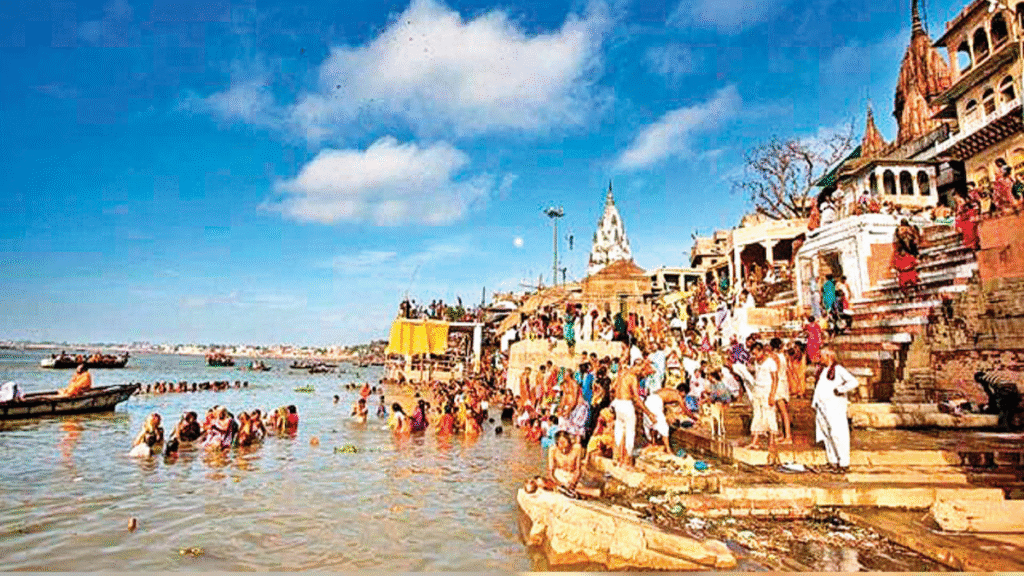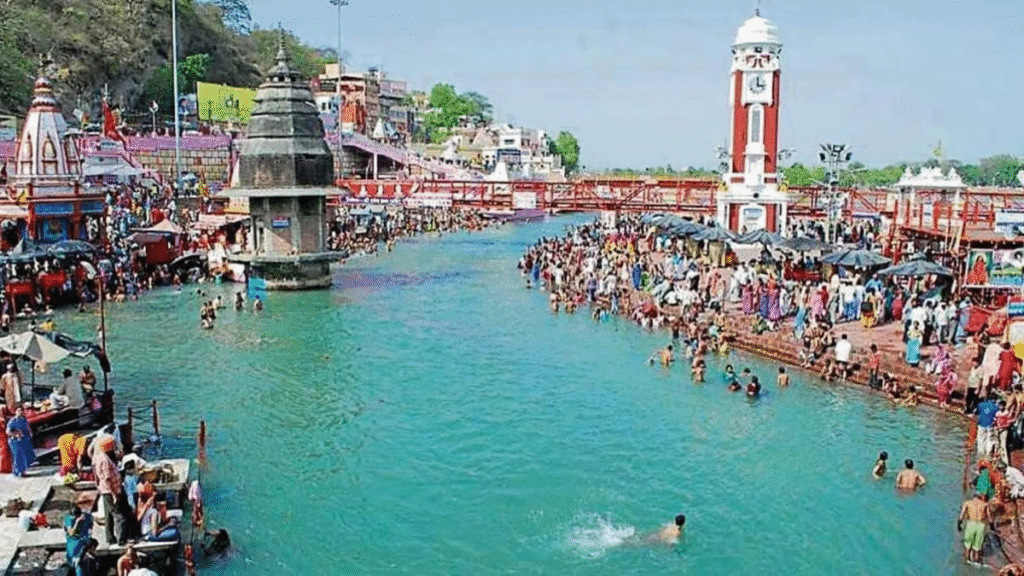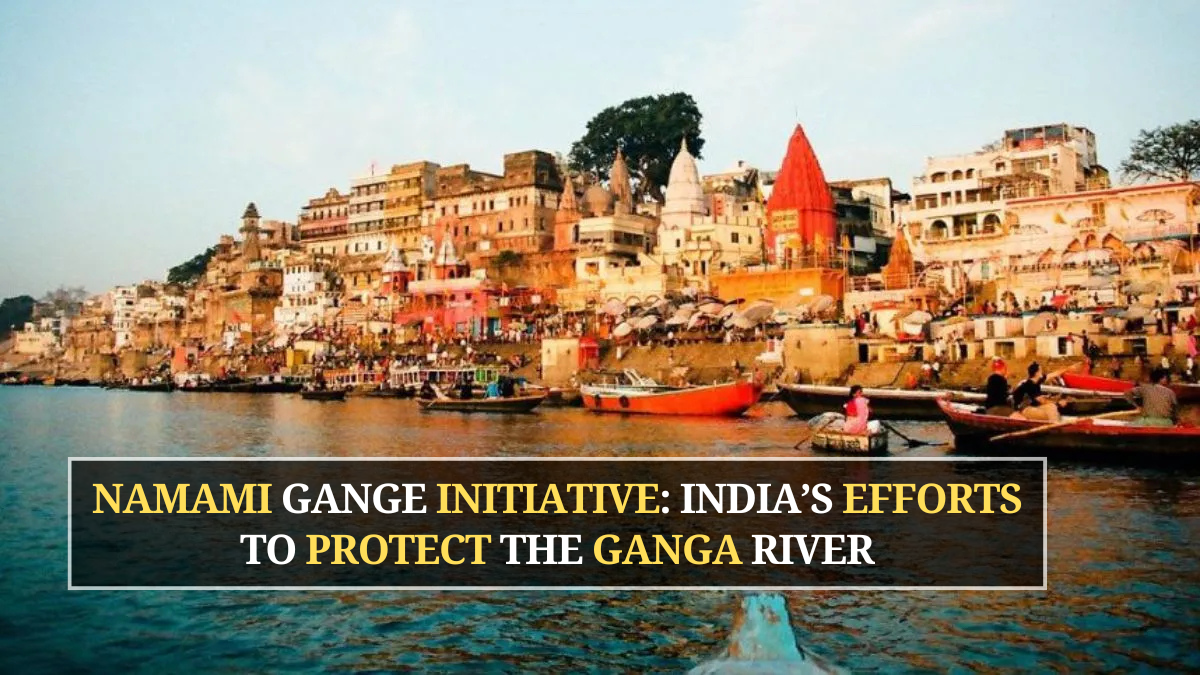The Namami Geng program is’ an integrated conservation assignment, approved by the Central Government in June 2014 as the ‘flagship program’ of the Central Government, where the National River with a budget exchange of RS 20,000 crore to achieve the twin goals for contamination and conservation of walking and protection and the protection.
The government of India (Goi) introduced Namami Gange.
The program (NGP) in 2014-15 has been expanded for five years with a budget expense of 20,000 crore for five years for the resuscitation of the Ganges River and its side rivers, and further by March 2026 with a budget expense of £ 22,500 crore.

The National Ganga Plan (CS) has been provided with a budgetary outlay of ₹3,400 crore [1] for 2025-26. This investment seeks to increase sewage treatment capacity, improve water quality, and control industrial waste discharge to revitalize the Ganga River and reach prescribed bathing standards by 2025.
Ganga: Lifeline of India
The Ganga River, one of the holiest rivers in the world, is under severe threat from over-extraction of water and contamination. As part of India’s cultural heritage and a prime source of sustenance, the health of the river becomes a top priority.
In an effort to tackle these challenges, the Namami Ganga initiative was commenced with the dual goal of efficiently curbing pollution and conserving and rejuvenating the River Ganga.
The Ganga River Basin
The Ganga River basin is India’s largest, covering 27% of India’s land area and hosting around 47% of the population. The basin extends across more than 11 states and occupies almost 27% of the geographical area of India. Agriculture occupies most of the basin, approximately 65.57%, while water bodies occupy 3.47% of the land area.
Even though it receives 35.5% of the overall water inflow in the form of rainfall, the Ganga River Basin is the second most water-scarce basin in India, after the Sabarmati Basin, with only 39% of the mean per capita per year rainwater inflow among large Indian river basins.
Vision
The Ganges rejuvenation is one of the rejuvenation of restoring the river’s grossness, which means to secure the “continuous country” (continuous current), “Nirmal Dhara” (unexpected flow), and its geological and organic bulk.
A wide ganga River Basin Management Scheme (GRBMP) was designed through a union of seven IITs with a wide ganga River Basin Management Scheme (GRBMP) focusing on an integrated River Basin Management (IRBM) approach through multiregional and multi-agency interventions.
Key Interventions
- Pollution Abatement (Nirmal Ganga): Containing and minimizing the causes of the pollution in the river.
- Improving Ecology and Flow (Aviral Ganga): Increasing the ecological balance and perennial flow of the river.
- Strengthening People-River Connect (Jan Ganga): Creating a greater bond between the people and the river through community interaction and awareness.
- Facilitating Research and Policy (Gyan Ganga): Encouraging diversified research, scientific mapping, studies, and evidence-based policy making
Years of collective efforts by NMCG are now starting to yield results in restoring the original beauty of the river.
Progress Overview (Up to 31 January 2025)
- A total of 492 projects worth 40121.48 crore have been inaugurated.
- Out of these, 307 projects have been completed and are operational.
- A remarkable 206 projects related to sewage infrastructure have been initiated.
- A massive fund of 33003.63 crore has been approved for such sewage infrastructure projects.
- Out of these, 127 sewerage projects have been successfully completed and have been instrumental in reducing pollution.
- Furthermore, 56 projects related to biodiversity and afforestation have been carried out.
- These projects have been allotted a fund commitment of more than ₹ 905.62 crore.
- In particular, 39 projects relating to biodiversity and afforestation have been successfully completed, enriching the ecological balance of the Ganga basin.
Government’s Recent Efforts Towards a Pollution-Free Ganga

In a significant direction towards addressing pollution, the 60th Executive Committee Meeting of the National Mission for Clean Ganga (NMCG) sanctioned the diversion and interception of the Durga Drain and the establishment of a 60 MLD capacity sewage treatment plant (STP) at Varanasi, Uttar Pradesh, at a cost of ₹274.31 crore.
This venture, on the hybrid annuity model, comprises a 75 MLD capacity main pumping station and other vital structures, providing long-term wastewater management and pollution control.
Moreover, another major project was sanctioned to curb the flow of untreated sewage into Varuna, an important tributary of the Ganga, in Bhadohi. With a capital outlay of ₹127.26 crore, this project will set up three STPs with capacities of 17 MLD, 5 MLD, and 3 MLD, and a comprehensive sewer network to capture four major drains to avoid pollution.
The project is under the DBOT pattern, which will ensure operation and maintenance in a sustainable manner for the next 15 years.
A national framework for safe reuse of treated water has been framed by NMCG to direct states in preparing their reuse policies and framing economic models for reuse of treated wastewater.
NMCG has also published a guidance handbook for urban policymakers and city authorities on safely reusing treated water, with the aim of conserving freshwater resources and ensuring water management practices on sustainable lines.
Seven biodiversity parks in seven districts of Uttar Pradesh (Mirzapur, Bulandshahar, Hapur, Budaun, Ayodhya, Bijnore and Pratapgarh) and 5 priority wetlands in Uttar Pradesh (3), Bihar (1) and Jharkhand (1) have been approved.
NMCG, under the State Forest Department, has taken up a forestry intervention scheme along the mainstream of the river Ganga. An area of 33,024 hectares has been afforested at a cost of approx. ₹ 398 crore.
143.8 lakh Indian Major Carp (IMC) fingerlings have been ranched in the Ganga since 2017 to protect fish biodiversity and the prey base of river dolphins and maintain the livelihood of fishermen in the Ganga basin under the special project of the Central Inland Fisheries Research Institute (CIFRI).
As many as 203 sewerage infrastructure projects worth ₹ 32,613 crore have been undertaken for cleaning up polluted river stretches with treatment facilities of 6,255 million liters per day (MLD). 127 STP projects with a capacity of 3,446 MLD have been completed and operationalized.
Read More:- Ganga Utsav Celebrated at Chandi Ghat, Haridwar on the Banks of River Ganga
For abatement of industrial pollution, 3 nos. of Common Effluent Treatment Plants (CETPs) have been approved, i.e., Jajmau CETP (20 MLD), Banther CETP (4.5 MLD), and Mathura CETP (6.25 MLD). Two projects, i.e., Mathura CETP (6.25 MLD) and Jajmau CETP (20 MLD), have been accomplished.
Conclusion
The National Mission for Clean Ganga (NMCG) attempts to utilize the finest knowledge and resources available across the world in rejuvenating Ganga.
With a marked success in different interventions, the program continues to aim towards its objective of having a clean and thriving Ganga for generations to come.
FAQs:-
What is the Namami Gange initiative?
Namami Gange is a flagship program launched by the Indian government to clean and rejuvenate the River Ganga through conservation, sanitation, and pollution control.
What are the main objectives of Namami Gange?
The mission focuses on pollution abatement, sewage treatment, river surface cleaning, and public awareness.
What cities are included in the Namami Gange project?
Major cities like Haridwar, Varanasi, Kanpur, Patna, and Kolkata along the Ganga are involved.

